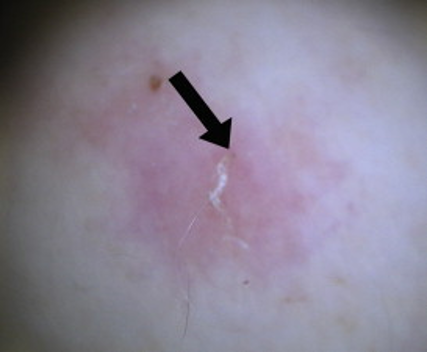PCR para escabiosis
TCHING TO SEE IF POLYMERASE CHAIN REACTION MITE BE THE FUTURE OF DIAGNOSING SCABIES

By Warren R. Heymann, MD
January 6, 2021
Vol. 3, No. 1

Scabies is an infestation of the skin by the miteSarcoptes scabiei. Transmission is by direct skin-to-skin contact or indirectly through fomites. Symptoms typically appear 3 to 6 weeks after an infestation. In patients with a prior exposure to the mite, symptoms can appear as early as 24 hours post exposure. Lesions consist of pruritic erythematous papules with excoriations. They're usually symmetrical and involve the interdigital webs, the flexural aspect of wrists, the axillae, the peri-umbilical area, elbows, buttocks, feet, genital area in men, and the peri-areolar area in women (called the circle of Hebra). The entire integument, including the face and the scalp, can be involved in infants, the elderly, and immunosuppressed patients. The pathognomonic sign is the burrow, representing the tunnel that the female mite digs to lay her eggs. Crusted scabies (CS) is a severe form that occurs in immunosuppressed individuals such as patients with AIDS, manifesting with extensive hyperkeratosis, predominantly over the scalp and the extremities. (2)

The brilliance of Bonomo and Cestoni is magnified by my own difficulty in identifying mites, eggs, or scybala within skin scrapings. Thinking of scabies in a differential diagnosis is easy (except in atypical cases!) — securing the diagnosis is another issue.
A Delphi study of the International Alliance for the Control of Scabies (IACS) has proposed the following criteria for the diagnosis of scabies (the diagnosis may be rendered on any of the levels; for levels B and C, scabies should be diagnosed after ruling out other disorders in the differential diagnosis) (3):
A: Confirmed scabies having at least one of: (A1) — mites, eggs, or feces on light microscopy of skin samples; (A2) — mites, eggs, or feces visualized on individual using a high-powered imaging device; (A3) — mite visualized on individual using dermoscopy.
B: Clinical scabies having at least one of: (B1) — scabies burrows; (B2) — typical lesions affecting male genitalia; (B3) — typical lesions in a typical distribution and two history features (itch or close contact with pruritus or a typical case of scabies).
C: Suspected scabies having one of: (C1) — typical lesions in a typical distribution and one history feature; (C2) — atypical lesions or atypical distribution and two history features.
I am almost embarrassed to admit it, but I would add a "D" category — pruritic patients with no obvious lesions or laboratory findings, for whom I prescribe either empiric permethrin or oral ivermectin, hoping that it would cure the patient. I'd be willing to wager that I'm not the only dermatologist who has resorted to this dermatological chicanery.
Using mineral oil scrapings may be the gold standard for diagnosis, but it takes skill. One of my partners is particularly adept at finding mites, while I often struggle with these preparations. I feel more confident with dermoscopy, looking for the "delta" (the dark brown triangular structure corresponding to the mite's anterior at the end of the burrow). Others advocate the burrow ink test. (4,5)
In that context, I was most intrigued by the study by Delaunay et al who evaluated polymerase chain reaction (PCR) as a diagnostic method for scabies using nonexpert-dependent standardized sampling.
Dry swabs were systematically rubbed across the front of both wrists, the eight interdigital spaces, and on any suspected scabies lesions in all patients referred for scabies. A new PCR-based diagnostic test was run on the samples. All patients underwent clinical and dermoscopic examination. Scabies diagnosis was confirmed when dermoscopic examination was positive or the patient had typical clinical signs of scabies. A total of 164 patients were sampled; 87 had confirmed scabies and 77 did not. Of the 87 patients with proved scabies, 33 patients had positive scabies PCR, resulting in a 37.9% sensitivity and a 61.7% negative predictive value. None of the 77 patients ruled out for scabies had a positive PCR result. The authors concluded that scabies PCR is specific but has poor sensitivity. Regardless, this PCR diagnostic method based on nontraumatic standardized skin sampling is not expert-dependent and is reproducible. This diagnostic method may be relevant as a non-expert sentinel diagnosis tool in large clusters where a scabies outbreak is suspected, such as nursing homes or other long-term care facilities. (6)
As much as I enjoy my consultative practice, I would be fine without seeing patients sent from facilities with the only clinical information being "rule out scabies." I'm itching for the development of a PCR analysis with a higher sensitivity for scabies — that would be a boon for institutional administrators, practitioners, and patients alike.
Point to Remember: Scabies may be the easiest or hardest diagnosis to render. Perhaps development of novel techniques such as PCR will simplify the process.
Our Expert's Viewpoint
Aileen Y. Chang, MD
Assistant Clinical Professor of Dermatology
University of California, San Francisco
International Alliance for the Control of Scabies (www.controlscabies.org)
In this day and age, it is hard to believe that we still do not have a sensitive point-of-care test for scabies. While the diagnostic PCR method published by Delauney et al. will not help us with diagnosing individual patients with scabies, it may be a potential diagnostic method for settings where the diagnosis of one individual with scabies would result in treatment of many other individuals. These settings include long-term care facilities, prisons, and childcare facilities, among others. Most of these facilities do not have quick access to a scabies expert and when faced with a potential scabies outbreak, they need to make an informed decision on whether or not to treat. In a large facility, treatment for scabies is expensive and time-intensive, requires development of a structured implementation plan, and can have a significant toll on staff and facility residents. The decision to treat scabies in these settings cannot be taken lightly. This diagnostic method has a sensitivity of 90.8% with five samples and 99.1% with 10 samples. As the authors conclude, their findings need to be validated in the context of an outbreak and with adults, as most individuals in the study were children. Delauney et al.'s work is a step in the right direction.
Arlian LG, Morgan MS. A review of Sarcoptes scabiei: Past, present, and future. Parasit Vectors 2017; 10: 297.
Khalil S, Abbas O, Kibbi AG, Kurban M. Scabies in the age of increasing drug resistance. PLoS Negl Trop Dis 2017: 11 (11): e0005920
Engelman D. Fuller LC, Steer AC, International Alliance for the Control of Scabies Delphi panel. Consensus criteria for the diagnosis of scabies: A Delphi study of international experts. PLoS Negl Trop Dis 2018;12(5):e0006549
Tang J, You Z, Ran Y. Simple methods to enhance the diagnosis of scabies. J Am Acad Dermatol 2019; 80: e99-100.
Leung V, Miller M. Detection of scabies: A systematic review of diagnostic methods. Can J Infect Dis Med Microbiol 2011; 22: 143-146.
Delaunay P, Hérissé AL, Hasseine L, Chiaverini C, et al. Scabies polymerase chain reaction with standard dry swab sampling: An easy tool for cluster diagnosis of human scabies. Br J Dermatol 2020; 182: 197-201.
All content found on Dermatology World Insights and Inquiries, including: text, images, video, audio, or other formats, were created for informational purposes only. The content represents the opinions of the authors and should not be interpreted as the official AAD position on any topic addressed. It is not intended to be a substitute for professional medical advice, diagnosis, or treatment.
DW Insights and Inquiries archive
Explore hundreds of Dermatology World Insights and Inquiries articles by clinical area, specific condition, or medical journal source
Skin Care Physicians of Costa Rica
Clinica Victoria en San Pedro: 4000-1054
Momentum Escazu: 2101-9574
Please excuse the shortness of this message, as it has been sent from
a mobile device.
posted by dermatica at
January 06, 2021
![]()
![]()

0 Comments:
Post a Comment
Subscribe to Post Comments [Atom]
<< Home